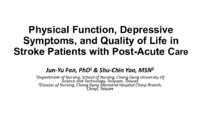Acute Stroke Management: Capturing the Walk-In Patient
View File(s)
Author Information
- Author(s)
- Details
-
Leigh Anne Schmidt, MSN, RN, NE-BC; Anthony Filippelli, MSN, RN, CEN, NE-AC
- Sigma Affiliation
- Non-member
Visitor Statistics
Visits vs Downloads
Visitors - World Map
Top Visiting Countries
| Country | Visits |
|---|
Top Visiting Cities
| City | Visits |
|---|
Visits (last 6 months)
Downloads (last 6 months)
Popular Works for Schmidt, Leigh Anne by View
| Title | Page Views |
|---|
Popular Works for Schmidt, Leigh Anne by Download
| Title | Downloads |
|---|
View Citations
Citations
The citations below are meant to be used as guidelines. Patrons must make any necessary corrections before using. Pay special attention to personal names, capitalization, and dates. Always consult appropriate citation style resources for the exact formatting and punctuation guidelines.
Item Information
Item Link - Use this link for citations and online mentions.
Abstract
Session J presented Saturday, September 29, 11:30 am-12:30 pm pm Purpose: The journey to comprehensive stroke certification identified opportunities for improvement in the treatment of stroke patients in the ED. This allowed the team to examine the process of care delivery and missed opportunities. One missed opportunity is the walk in stroke patient. This project created a process to identify a stroke patient at arrival and decrease time to stroke notification call. Design: This initiative looked at the quality of care provided and established benchmarks of arrival to stroke team notification and door to CT scan for acute stroke patients. This was a staff development and quality assurance project to enhance quality of our walk in stroke patients. This project allowed for better outcomes and future success in the care of stroke patients. Setting: Urban, teaching, comprehensive stroke center and Level I trauma center Participants/Subjects: All ED nurses and physicians worked on this project. Methods: Striving for excellence through comprehensive stroke certification the team embarked on a journey to decrease the door to Stroke activation time for walk in stroke patients. A thorough assessment of the complex process was completed and it was recognized that the delay was related to symptom recognition and presentation to the physician. The multidisciplinary team identified ways and processes to streamline the intake process and MD presentation. Education was provided to all staff and mock drills were used to hardwire the process. Results/Outcomes: The door to Code Stroke activation decreased from 19 minutes(2016) to 15 minutes (2017). This allowed for door to CT complete to drop from 50 minute to 29 minutes(20-17). Implications: An efficient high performing team will result in safe quality patient care. This team showed that utilizing team performance principles, success can be achieved. The team is now working on decreasing the door to needle goal even further to 45 minutes 100% of the time.
Description
Emergency Nursing 2018. Held at David L. Lawrence Convention Center, Pittsburgh, Pennsylvania, USA
Repository Posting Date
2019-01-18T17:31:20Z
Type Information
| Type | Poster |
| Acquisition | Proxy-submission |
| Review Type | Abstract Review Only: Reviewed by Event Host |
| Format | Text-based Document |
Category Information
| Evidence Level | N/A |
| Research Approach | N/A |
| Keywords | Stroke Management; Stroke Quality; Comprehensive Stroke Certification |
Conference Information
| Name | Emergency Nursing 2018 |
| Host | Emergency Nurses Association |
| Location | Pittsburgh, Pennsylvania, USA |
| Date | 2018 |
Rights Holder
All rights reserved by the author(s) and/or publisher(s) listed in this item record unless relinquished in whole or part by a rights notation or a Creative Commons License present in this item record.
All permission requests should be directed accordingly and not to the Sigma Repository.
All submitting authors or publishers have affirmed that when using material in their work where they do not own copyright, they have obtained permission of the copyright holder prior to submission and the rights holder has been acknowledged as necessary.
Related items
Showing items related by title, author, creator and subjects.
-
Save a Brain- Getting your ED ready for Comprehensive Stroke Certification
Newnam, Karen; Blue-Matthews, Jamie; Rhew, Denise C.; Upham, Jason; Jarvis, Jessica; Clum, Jason; Bell, Michelle; Deaver, Jeremy; Spencer, Sara; Laffan, EileenSession D presented Thursday, September 27, 2:30-3:30 pm Purpose: Stroke is the 5th leading cause of death in the U.S. Our health system is located in the Southeastern part of the United States in the middle of the Stroke ... -
Physical function, depressive symptoms, and quality of life in stroke patients with post-acute care
Fan, Jun-Yu; Yao, Shu-ChinThe stroke patients with PAC program showed significantly gradual improvements in the BI, IADL, mRS, and QoL over time. The BI and GDS-15 were crucial predictive factors for patients' QoL on the 4th, 8th, and 12th week ... -
Comparison of three teaching methods on four-through-seven year old children's understanding of the lungs in relation to a peak flow meter in the management of asthma: A pilot study
Schmidt, Cheryl K.The purpose of this study was to compare the effects of three teaching methods on 4-through-7-year-old children's understanding of the lungs in relation to a peak flow meter in the management of asthma. Nineteen children, ... -
Risk factors for falls in adult stroke patients: A comprehensive model
Yoo, Jee HyeThe comprehensive model which could explain fall risk factors in stroke patients was constructed using theory synthesis. The model consisted of five categories, which were patients' general characteristics, physical function, ... -
Registered nurses' perceptions of being present for their patients
Kostovich, Carol Toliuszis; Collins, Eileen G.; Schmidt, Lee A. (2012-01-04)Evidence-Based Practice Session. The process of providing nursing care encompasses technical knowledge-based psychomotor skills as well as the interpersonal connection with patients. The Presence of Nursing Scale-RN version ...





